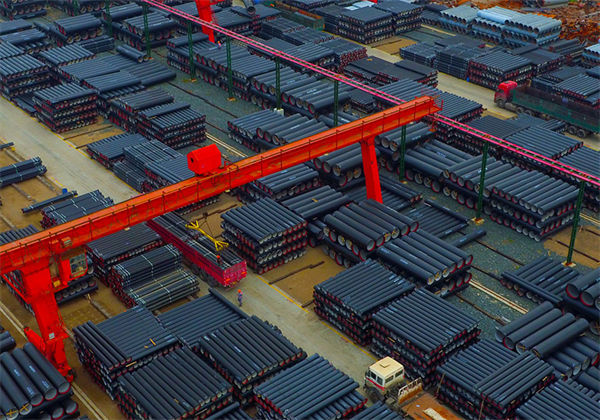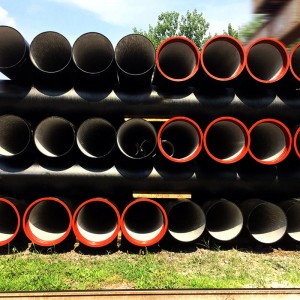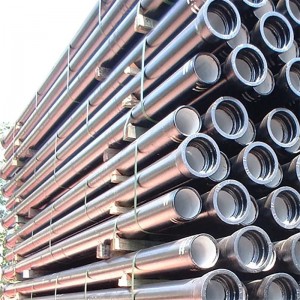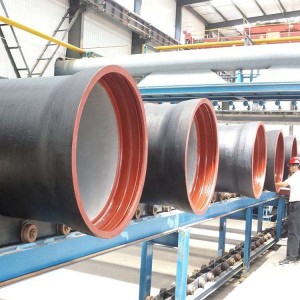Factory and Warehouse
Product Form
Ductile Iron Pipes All Types:
|
1 |
Material |
Ductile Cast Iron |
|
2 |
Joint Type |
T-Type(push-on joint) |
| K-Type(Mechanical Joint) | ||
| Self-Restrained | ||
| Flanged joint | ||
|
3 |
Standard |
ISO2531, EN545, EN598, etc |
|
4 |
Size |
DN80 - DN2600 (80mm - 2600mm) |
|
5 |
Classs |
K7, K8, K9, C40, C30, C25, etc |
|
6 |
Length |
6m, cut to 5.7m |
|
7 |
Internal lining
|
1. Portland cement mortar lining |
| 2. Sulphate Resistant cement mortar lining | ||
| 3. High-Aluminum cement mortar lining | ||
| 4. Epoxy Resin Lining | ||
| 5. Epoxy Ceramic Lining | ||
| 6. PU Lining | ||
|
8 |
External Coating |
Zinc+bitumen coating, |
| Customized coating such as Zinc-Epoxy, Alumina Powder, PU, FBE, Epoxy-Ceramic, etc. | ||
|
9 |
Rubber Gasket |
NBR rubber, SBR rubber or EPDM rubber ring as per ISO4633 |
|
10 |
Application |
Potable Water / Drinking Water/Sewage Water |
|
11 |
Packing |
DN100-DN300 in bundles; DN350-DN2600 in bulk ship |
Introduction

Our Ductile Iron Sewer Pipe for Sanitary Sewage Drainage is the ideal choice for efficient and reliable sewage transportation. Expertly crafted from premium ductile iron, these pipes are engineered to meet the demanding requirements of sewage drainage systems with unmatched performance.
With its sturdy construction, our Ductile Iron Sewer Pipe ensures exceptional strength and durability, capable of withstanding the challenges of sewage conveyance. Its corrosion-resistant properties protect against harsh sewage environments, ensuring a long service life and minimal maintenance.
Versatility is a key advantage of our Ductile Iron Drainage Pipe for Sanitary Sewer, available in various sizes to suit diverse projects, from residential sewage networks to large-scale industrial systems. The pipes' smooth inner surface facilitates seamless sewage flow, reducing the risk of blockages and ensuring smooth drainage.
Compliant with stringent industry standards, our pipes undergo rigorous testing, guaranteeing top-tier quality and safety. The Ductile Iron Sewer Pipe is designed to withstand the corrosive nature of sewage, providing a dependable and secure solution for sewage conveyance.
Embrace sustainability with our eco-friendly DI Pipes for Sanitary Sewer Drainage. Upgrade your sewage drainage infrastructure with this advanced piping solution, delivering unmatched performance and reliability. Experience smooth sewage flow, ensuring efficient sewage drainage for communities and industries alike. Choose our Ductile Iron Sewer Pipe and elevate your sewage conveyance capabilities to new heights.
Benefits of ductile iron pipe

Solid under loads
In underground conditions, the ductile cast iron pipe has a semi-rigid behaviour: it offers an excellent compromise between mechanical stress in the wall (small DN) and ovality (large DN). It can be laid in high and low height of cover, and easily in soil of low rigidity. The ”ground/semi-rigid pipe” system offers optimum mechanical stability over time, without risk of buckling in large DN.

Insensitive impacts
The ductile cast iron structure has a high elastic deformability and a high resistance to crack initiation: it results in excellent impact resistance. The cast iron pipes are perfectly suited to transport conditions over long distances (truck, train or ship), handling conditions on sites and to different types of backfilling. The ductile cast iron pipelines may be laid in very difficult areas: rocky mountain slopes for hydroelectric plants, crossings for cantilever bridges, rockfill for submarine outlets.

Push-in joint system

Excellent hydraulicity
The centrifugation process ensures a perfectly smooth and even cement surface. The Colebrook roughness coefficient of an isolated pipe is k = 0.03 mm. We recommends the use of an average value of k = 0.1 mm for sizing networks in order to take into account all the different load losses caused by singular points (tee fittings, elbows, valves, etc.)

Pressure resistance
The ductile cast iron pipe are designed to withstand pressures much greater than the values usually encountered on the networks. The wall thickness is calculated with a safety factor of 3 with respect to the maximum operating pressure. This additional safety margin is very useful to the impacts during installation, accidental overpressure and mechanical operating fatigue.











